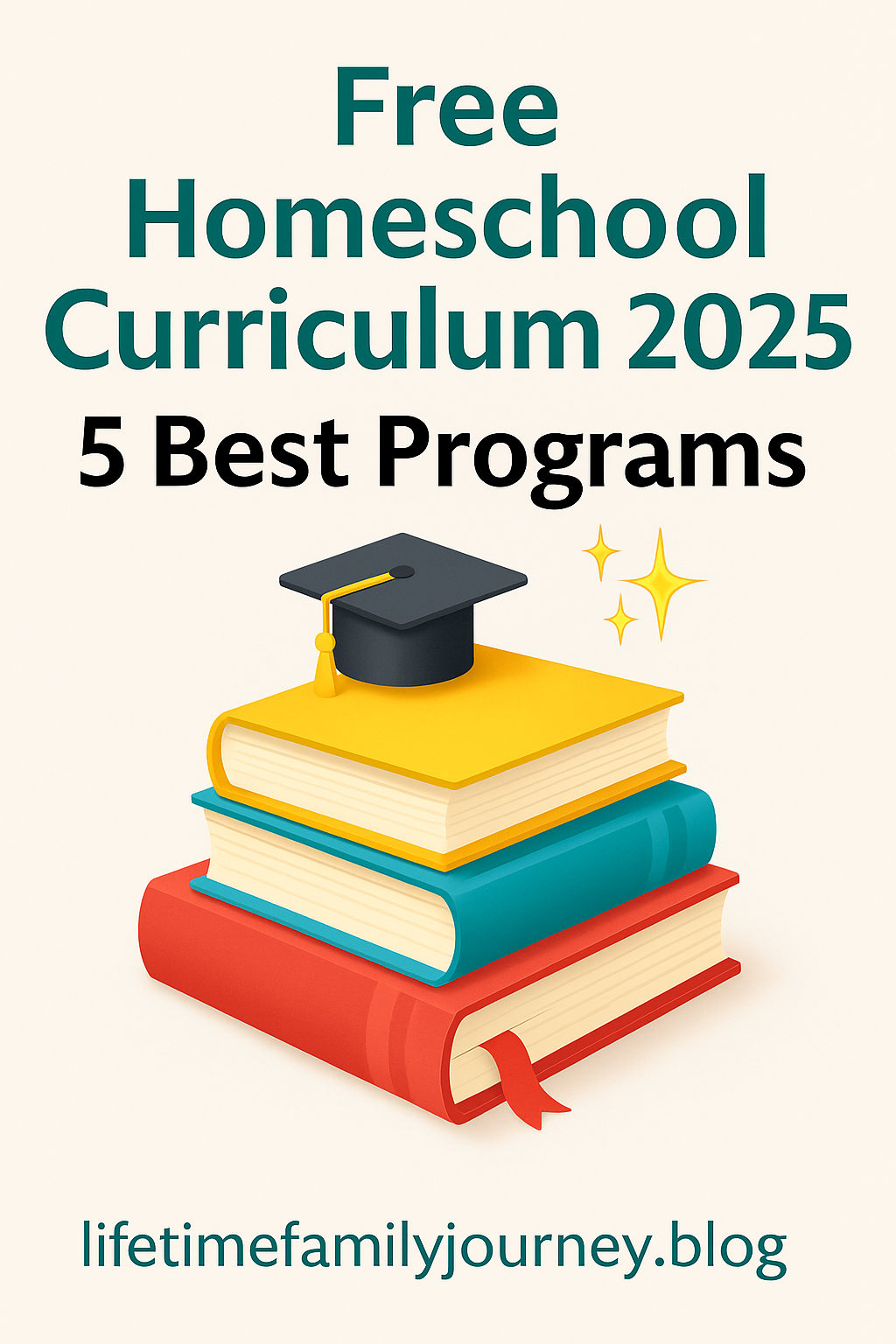Free Homeschool Curriculum 2025: 5 Best Programs 🎓✨

Many parents dream of homeschooling but freeze at the thought of curriculum costs. I’ve watched fellow military families move frequently, switching between public schools that never quite clicked, wondering if there was a better way. The good news? There is.
Just like when school is here and families scramble to prepare, the key is mindset and preparation, not expensive purchases.
The truth about free options might surprise you. Amazing programs exist without the $500-$1,500 price tags, but parents worry: are they accredited? Are they approved? Are they complete? Are they even legal?
After fifteen years of homeschooling my own six kids, I’ve tested these programs firsthand. Some worked brilliantly. Others left gaps we had to fill. This guide tackles those burning questions before diving into the top programs that actually deliver.
What “Free Homeschool Curriculum” Really Means
Let’s clear up the confusion that stops parents from starting. The homeschool world loves throwing around terms like “accredited” and “approved” without explaining what they actually mean for your family when choosing free homeschool curriculum options.
Accredited curricula are rare. Accreditation applies to schools and institutions, not curriculum packages. Most best free homeschool curriculum options aren’t accredited because they don’t need to be. When you homeschool, you become the school administrator. The curriculum is just your tool.
Some free virtual schools are accredited, but these count as public school enrollment, not independent homeschooling. If you’re seeking true homeschool freedom, you’ll likely use non-accredited curriculum resources.
Think of it like cooking. You don’t need a “certified” recipe to make dinner—you need ingredients that work. Same principle applies when selecting free homeschool curriculum for your family.
State-approved stamps are even rarer. Unless you enroll in a public virtual academy (which technically isn’t homeschooling), you won’t see “state-approved” labels. But here’s what matters: homeschool curriculum 2025 options that are free can still help you meet your state’s legal requirements.
Most states require proof of education through portfolios, testing, or evaluations. The free homeschool curriculum itself doesn’t need government approval—your teaching does the work.
Homeschooling isn’t rare any longer—NCES reports that approximately 5.2% of school-age children received instruction at home in 2022–23, up from 3.7% in 2018–19. Specifically, Pew Research finds that 3.4% of K‑12 students were homeschooled that year. These rising numbers signal growing trust in parent-led education—and growing familiarity with smart, adaptable options like free homeschool curricula.
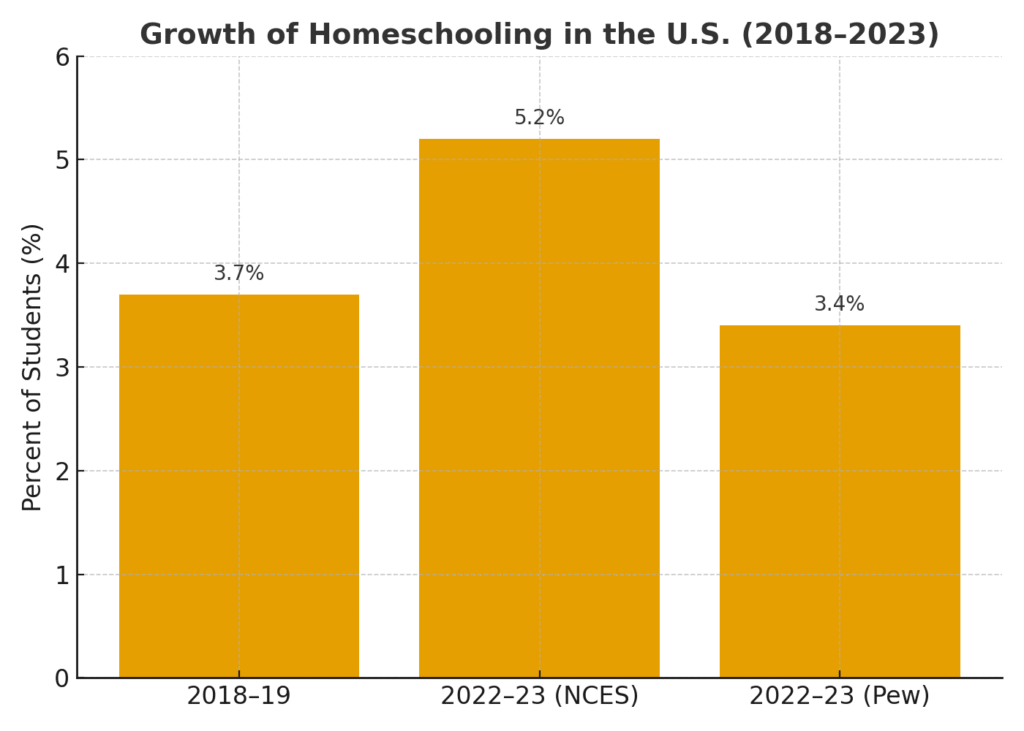
✅ Standards alignment varies by program. Some free online homeschool curriculum options align with Common Core standards (like Khan Academy). Others follow classical or Charlotte Mason approaches (like Ambleside Online).
Alignment doesn’t equal approval, but it helps parents feel confident they’re covering expected material. I’ve found aligned free homeschool curriculum useful for standardized test prep, but they’re not mandatory for legal homeschooling.
Complete vs. subject-based programs create different planning loads. All-in-one free homeschool curriculum programs like Easy Peasy provide daily lessons across every subject. Subject-specific programs like Khan Academy excel in math and science but require you to find language arts elsewhere.
Most successful homeschool families I know mix and match free homeschool curriculum options. We used Khan for math, Ambleside for literature, and Easy Peasy for science during different seasons of our journey. Building healthy family routines that work requires the same flexibility and adaptation.
📌 Transcripts and diplomas require parent action. Free homeschool curriculum programs don’t issue official transcripts or diplomas—that’s your job as the school administrator. You track progress, assign grades, and create transcripts. Many parents partner with umbrella schools for official documentation if needed.
Top 5 Free Homeschool Curriculum Programs for 2025
After testing dozens of free homeschool curriculum options with my own six kids and connecting with hundreds of other homeschool families, these five consistently deliver quality education without the price tag.
Easy Peasy All-in-One Homeschool
What it offers: Complete Pre-K through 12th-grade curriculum with structured daily lessons, Christian worldview integration, and print-friendly formats.

Easy Peasy became our go-to during military moves because everything was online and immediately accessible. No shipping delays, no lost books during PCS season. The home organization strategies that work for large families also apply to educational resources—accessibility and simplicity win.
🔍 Accredited? No. It’s parent-led curriculum, not an accredited institution.
🔍 Approved? Not state-approved. Parents file under their state’s homeschool laws.
🔍 Aligned? Mixed educational sources with Christian perspective. Not Common Core aligned.
🔍 Complete? Yes, covers all grades and core subjects with daily structure.
Where it shines: The daily lesson format eliminates planning time. Click, teach, done. Perfect for busy parents or families new to homeschooling who need hand-holding.

Where it needs help: Advanced STEM labs for high school require outside supplements. Foreign language options are limited beyond Spanish basics.
My daughters used Easy Peasy for elementary science and loved the hands-on experiments. The instructions were clear enough that they could work independently while I helped their younger siblings.
Khan Academy
What it offers: Video-based learning platform with mastery-focused quizzes, progress tracking, and teacher dashboards for parent oversight.
Khan Academy revolutionized our math struggles. My son went from dreading algebra to actually enjoying problem-solving through their incremental approach. Research shows that students who use Khan Academy for 30+ minutes weekly achieve 20% higher learning gains compared to expected growth rates.

🔍 Accredited? No—it’s a learning platform, not an accredited school.
🔍 Approved? Not state-approved, but widely recognized and used in traditional schools.
🔍 Aligned? Strong Common Core alignment for mathematics. Excellent for standardized test preparation.
🔍 Complete? No. Exceptional for math and sciences, but lacks comprehensive humanities coverage.
Where it shines: The mastery-based approach ensures kids truly understand concepts before moving forward. No more rushing through material just to check boxes.
Where it needs help: Reading and writing programs require separate resources. History coverage is scattered and incomplete for full curriculum use.
💡 Pro tip: Pair Khan Academy math with Ambleside Online literature and Easy Peasy science for a well-rounded elementary program.
Ambleside Online
What it offers: Charlotte Mason methodology using living books, nature study, and rich literature instead of textbook-based learning.
This program transformed how my girls approached learning. Instead of worksheets, they read real books written by passionate authors. Their writing improved dramatically through copywork and narration exercises.
🔍 Accredited? No. Parent-implemented classical education approach.
🔍 Approved? Not state-approved. Follows Charlotte Mason’s educational philosophy.
🔍 Aligned? Classical education focus, not Common Core. Emphasizes liberal arts and character formation.
🔍 Complete? Yes, it’s complete in philosophy, but families typically supplement math and sciences.
Where it shines: Rich, literature-based education that develops critical thinking and excellent writing skills. Children read primary sources instead of dumbed-down textbook summaries.
Where it needs help: Math instruction requires separate curriculum (Khan Academy pairs perfectly). Science labs need supplementation for hands-on learning.

The book lists seem overwhelming initially, but libraries and used book sources make it affordable. My oldest daughter credits Ambleside’s living books approach for her acceptance into George Mason University’s education program.
Discovery K12
What it offers: Secular online platform providing complete K-12 curriculum with daily assignments, automatic grading, and optional paid progress reports.
Discovery K12 provided structure during a particularly chaotic deployment when consistency was crucial for my kids’ emotional stability.
🔍 Accredited? The free version is not accredited. Paid upgrade claims accreditation, but always verify whether your state or college recognizes it.
🔍 Approved? Not state-approved, but generates records acceptable for homeschool documentation.
🔍 Aligned? Some Common Core alignment with secular presentation of all subjects.
🔍 Complete? Yes, covers all core subjects K-12 with automated lesson plans.
Where it shines: Completely automated lesson planning eliminates parent prep time. Kids can work independently while parents focus on other children or responsibilities.
Where it needs help: Limited hands-on science labs. Elective options are basic compared to specialized programs.

🚨 Important note: The free version includes advertising. Consider this factor if you’re sensitive to commercial content during school time.
Freedom Homeschooling
What it offers: Curated directory of free educational resources organized by subject and grade level rather than a complete curriculum package.
Freedom Homeschooling became my research starting point when planning each school year. Instead of one-size-fits-all approaches, I could customize education for each child’s learning style.
🔍 Accredited? No—it’s a resource directory, not an educational institution.
🔍 Approved? No approval status. Parents choose from listed resources.
🔍 Aligned? Varies by resource. Parents select alignment preferences.
🔍 Complete? Not by itself. Requires significant parent planning and resource compilation.

Where it shines: Ultimate flexibility to match each child’s interests and learning style. Incredible variety of high-quality free resources.
Where it needs help: Requires substantial parent time for planning and coordination. Not suitable for parents seeking structured, done-for-you approaches.
I used Freedom Homeschooling to find specialized resources like art appreciation courses and advanced chemistry labs that weren’t available in complete curriculum packages.
📄 Want a printable comparison chart?
Download the Free Homeschool Curriculum 2025 Quick Guide (PDF)
Essential Supplements for a Well-Rounded Free Education
Even the most complete homeschool resources free programs benefit from strategic additions. Here’s what we’ve learned works best when building a comprehensive educational foundation:
Open Educational Resources (OER) fill specific gaps beautifully. CK-12 provides interactive science simulations. OpenStax offers college-level textbooks for advanced high school students. EdX courses give teenagers real college experience.
My daughter completed an MIT introduction to psychology course through EdX during her junior year. The college credit transferred to George Mason University, saving us hundreds in tuition costs.
Local community resources often surpass expensive supplements. Libraries offer story times, maker spaces, and research databases. Museums provide hands-on science and history experiences. 4-H, scouts, and homeschool co-ops create social learning opportunities.
👉 Digital tools enhance engagement without breaking budgets. Duolingo makes foreign language learning game-like and addictive. Prodigy turns math practice into adventure gaming. TypingClub develops essential technology skills.
High school additions become more critical for advanced learners. Outschool offers specialized classes taught by experts. Community college dual enrollment provides accredited transcripts. College Board’s free SAT prep ensures test readiness.
Our oldest used dual enrollment for calculus and chemistry lab requirements that were difficult to replicate at home. The credits counted toward both high school graduation and college prerequisites.
Free Homeschool Curriculum Comparison Guide
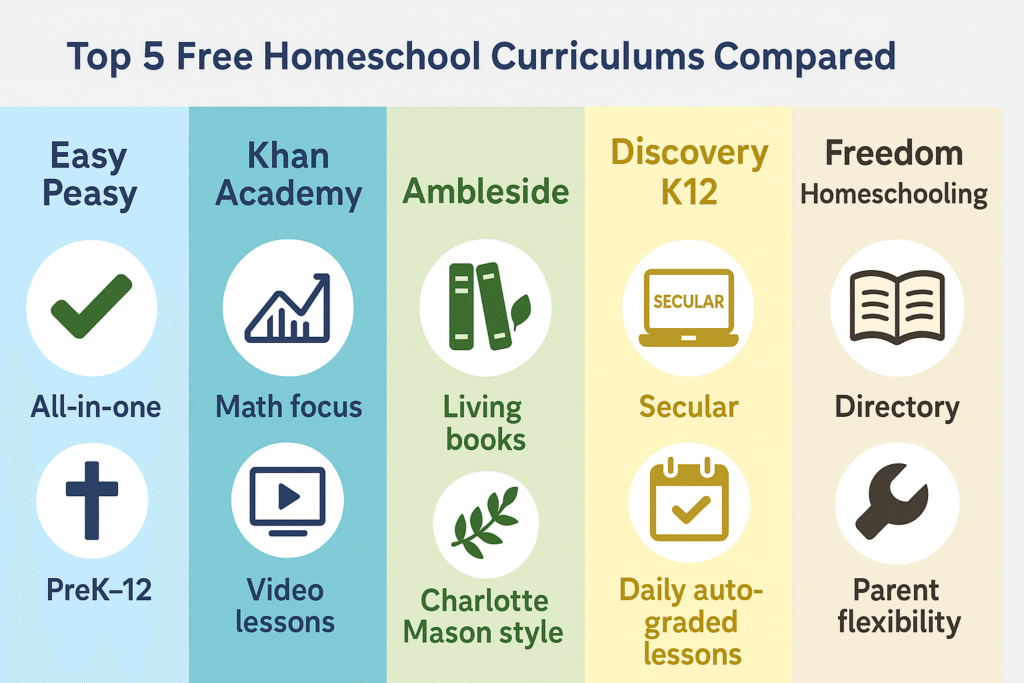
Parents often ask me to compare the top educational options side-by-side. Here’s what I’ve learned about each program’s strengths and limitations:
Academic Coverage Comparison
Complete Programs (All Subjects K-12):
- Easy Peasy All-in-One Homeschool
- Discovery K12
- Ambleside Online (requires book sourcing)
Subject-Specific Programs:
- Khan Academy (Math/Science focus)
- Freedom Homeschooling (Resource directory)
Time Investment Required
Low Parent Prep Time:
- Khan Academy (student-led videos)
- Discovery K12 (automated lessons)
Moderate Parent Prep Time:
- Easy Peasy (daily lesson review)
- Freedom Homeschooling (resource selection)
High Parent Prep Time:
- Ambleside Online (book sourcing, discussion leading)
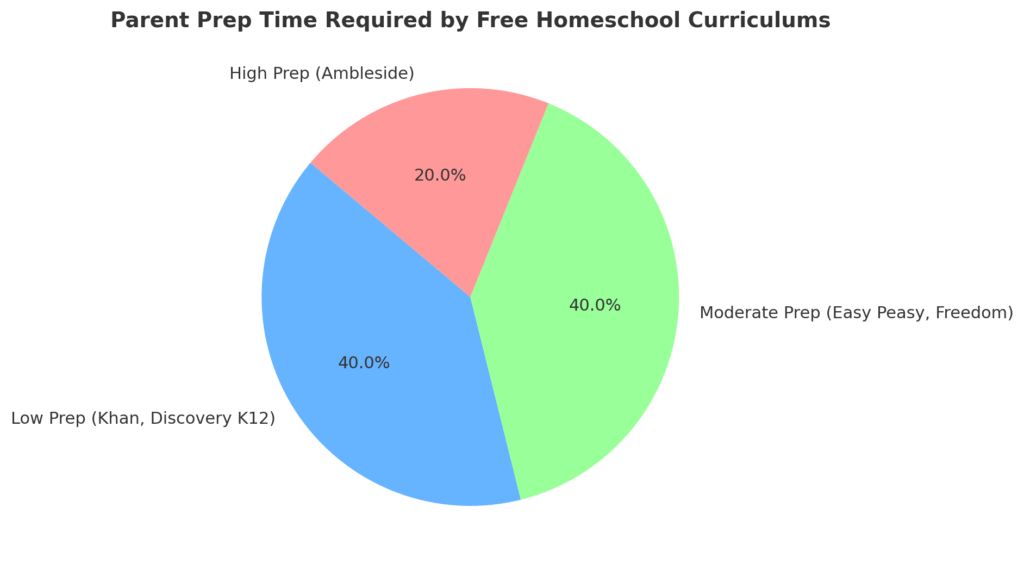
Best Fit by Learning Style
Visual Learners: Khan Academy’s video-based approach
Reading-Focused: Ambleside Online’s living books method
Structured Learners: Easy Peasy or Discovery K12 daily lessons
Independent Workers: Discovery K12 or Khan Academy
Hands-On Learners: Freedom Homeschooling resource variety
Technology Requirements
Internet Required:
- Khan Academy
- Discovery K12
Print-Friendly Options:
- Easy Peasy
- Ambleside Online
Mixed Format:
- Freedom Homeschooling (varies by resource)
Sample Free Homeschool Schedule: Mix and Match Success
Real families need practical examples, not theoretical planning. Here’s what actually works in our home:
Elementary Example (Grade 4)
Math: Khan Academy – 30 minutes daily with mastery-based progression
Reading/Language Arts: Ambleside Online living books plus copywork practice
Science: Easy Peasy daily lessons with suggested experiments
History: Discovery K12 modules supplemented with library documentaries
Extras: Freedom Homeschooling art and music resource links
This combination provided structure (Easy Peasy, Discovery K12) with flexibility (Ambleside books, Khan Academy pacing) that accommodated our family’s rhythm.
High School Example (Grade 9)
Algebra: Khan Academy with supplemental practice from CK-12
Biology: Discovery K12 lessons plus CK-12 virtual labs
Literature: Ambleside Online novel selections with discussion guides
Writing: Easy Peasy composition assignments with peer review
World History: OpenStax textbook with documentary supplements
💡 The key insight: Don’t feel pressured to use one program for everything. My kids learned best when we matched programs to their individual strengths and interests.
Our son thrived with Khan Academy’s visual math approach but needed Easy Peasy’s structured science experiments. Our daughters preferred Ambleside’s rich literature but used Discovery K12 for systematic history coverage.
When Free Isn’t Enough: Knowing When to Invest
Honest talk: sometimes free homeschool curriculum doesn’t meet specific family needs. After fifteen years using various free homeschool curriculum programs, I’ve learned to recognize when strategic paid additions make sense.
Accreditation becomes important for college-bound students. If your teenager needs official transcripts for competitive college admissions, consider umbrella school partnerships or accredited online programs for core subjects while keeping your free homeschool curriculum as the foundation.
Specialized interests require expert instruction. My daughters’ competitive cheerleading and gymnastics required professional coaching that no free homeschool curriculum could provide. We invested in their passions while keeping core academics free.
Learning differences may need targeted approaches. Free homeschool curriculum works wonderfully for typically-developing learners, but children with dyslexia, ADHD, or other challenges sometimes need specialized curricula with built-in accommodations.
📌 Strategic upgrade approach: Keep your core subjects using free homeschool curriculum (math, language arts, science, history) and add paid options only where clear gaps appear. This typically costs $200-$500 annually versus $1,000-$2,000 for complete paid packages.
Family bandwidth matters more than money sometimes. During particularly stressful military deployments, we invested in automated grading and lesson planning to preserve family harmony. The emotional benefits outweighed the financial costs, much like the home safety strategies that protect what matters most.
Legal Considerations Every Parent Should Know
The biggest fear stopping parents from choosing free homeschool curriculum isn’t quality—it’s legality. Let me address this directly based on my experience across multiple states during military moves.
Free homeschool curriculum meets legal requirements when properly documented. Every state requires proof of education, not specific curriculum approval. Portfolio reviews, standardized testing, or third-party evaluations satisfy legal requirements regardless of whether you used free homeschool curriculum or paid resources.
Keep detailed records of daily work, field trips, and learning experiences. I photograph completed projects, maintain reading lists, and document educational outings. These records demonstrate education is happening.
State notification requirements are separate from curriculum choices. Most states require annual letters of intent, attendance records, and end-of-year documentation. The curriculum you choose doesn’t affect these legal obligations. HSLDA provides comprehensive state-by-state legal summaries that clarify your specific obligations.
🚨 Research your specific state requirements thoroughly. Don’t rely on other parents’ experiences—laws vary significantly.
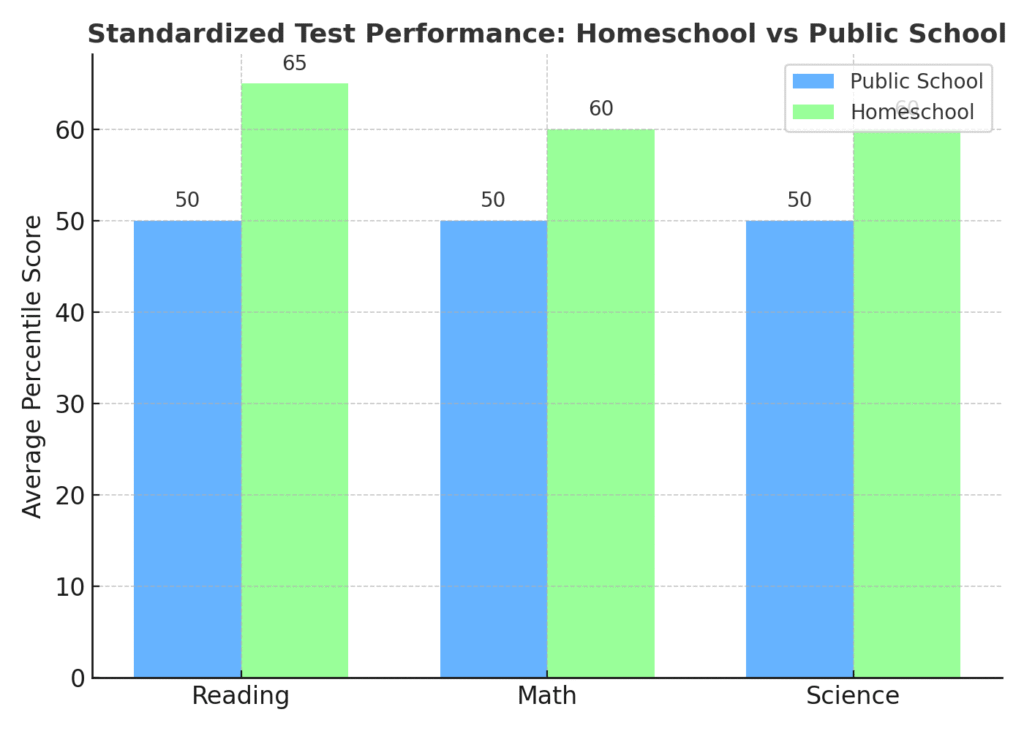
Testing requirements can be met regardless of curriculum choice. States requiring annual testing accept results whether students used expensive boxed curricula or free online resources. The test measures student knowledge, not curriculum cost.
My kids consistently scored above grade level on standardized tests using primarily free resources. The key was consistent daily instruction, not expensive materials. Research consistently shows homeschooled students achieve similar or higher academic performance compared to traditionally schooled peers across racial and socioeconomic lines.
Building Confidence in Your Free Curriculum Choice
The hardest part of choosing free homeschool curriculum isn’t finding quality programs—it’s trusting yourself to make good decisions for your children.
I struggled with imposter syndrome during our first year using free resources. Surely “real” education required expensive textbooks and structured lesson plans? My kids learned to read using library books and Khan Academy videos. They developed critical thinking through Socratic discussions about living books. They mastered math concepts through patient, individualized instruction.
Your teaching makes the difference, not the price tag. I’ve seen children excel with free resources under engaged parents and struggle with expensive curricula when parents weren’t involved. Your attention, encouragement, and consistency matter more than any purchased program.
Community support amplifies any curriculum choice. Connect with local homeschool groups, online forums, and experienced families using similar approaches. Isolation makes everything harder; community makes everything possible.
The homeschool families I most admire use mixed approaches—some free resources, some paid, some parent-created. They adjust based on their children’s needs, not marketing pressure or social expectations. This mirrors the positive mindset habits that transform how we approach challenges.
✅ Start with free options and adjust as you learn. You can always add paid resources later, but you can’t get refunds on expensive curricula that don’t fit your family. Free programs let you experiment without financial pressure.
Making the Final Decision
After reviewing options, researching legal requirements, and considering your family’s specific needs, the choice becomes clearer. You don’t need perfect curriculum—you need curriculum that works for your children right now.
Choose based on your teaching confidence level. New homeschoolers often benefit from structured programs like Easy Peasy or Discovery K12 that provide daily guidance. Experienced parents might prefer the flexibility of mixing Khan Academy, Ambleside Online, and Freedom Homeschooling resources.
Consider your children’s learning styles honestly. Visual learners thrive with Khan Academy videos. Bookworms love Ambleside’s living books approach. Hands-on learners need Easy Peasy’s experiment suggestions or supplemental lab kits.
Match programs to your family’s rhythm. Military families benefit from online-only options that survive frequent moves. Large families need independent learning options that don’t require constant parent guidance. Working parents appreciate automated lesson planning and grading.
👉 Remember: you can change directions. Homeschooling isn’t a permanent commitment to one approach. We’ve switched curricula, added programs, and dropped resources that weren’t working. Flexibility is one of homeschooling’s greatest advantages.
The best free homeschool curriculum 2025 has to offer is the one your children actually use consistently while meeting your state’s legal requirements. Start somewhere, document everything, and adjust as you learn what works for your unique family.
Your children won’t fall behind because you chose free homeschool curriculum. They’ll succeed because you’re paying attention to their individual needs and adjusting their education accordingly. That’s something no expensive curriculum can guarantee.
Frequently Asked Questions About Free Homeschool Curriculum
Q: Is free homeschool curriculum really complete enough for high school?
A: Yes, when combined strategically. I used Khan Academy for advanced math, Discovery K12 for science labs, and Ambleside Online for literature with my high school daughters. Both were accepted to George Mason University using transcripts based primarily on free resources.
Q: How do I know if my child is learning enough with free programs?
A: Document everything and use periodic assessments. Most states require annual testing or portfolio reviews anyway. The key is consistent daily instruction, not curriculum cost.
Q: What about college admissions with free curriculum?
A: Colleges care about student preparation, not curriculum expense. Strong SAT/ACT scores, dual enrollment credits, and well-documented transcripts matter more than whether you used free or paid resources.
Q: Can I switch between different free programs mid-year?
A: Absolutely! This flexibility is one of homeschooling’s greatest advantages. We’ve switched programs when they weren’t working and our kids never suffered academically.
✅ Still deciding? Grab the Free Curriculum Quick Guide (PDF) for a simple overview and planning tool.
Explore More from Our Family of Blogs
Mountains Will Move
Faith-based encouragement for everyday families.
Everyday Exposed
No-filter truth hub for critical thinking and clarity.
Thank you for being part of the community. God Bless you and your family.
